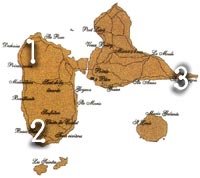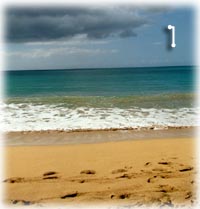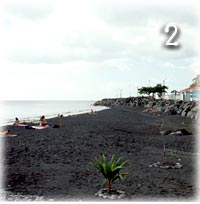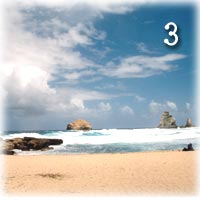 |
|
|
Why Guadeloupe, you wonder.
After a scenic flight from San Juan, we landed at Le Raizet airport in Pointe-à-Pitre. The first surprise was seeing oxen tethered in fields just next to the runway. The next was a ride over bumpy roads to the off-site rental car lot, located in a funny, half-deserted area that was the original airport. We had a fair distance to travel to our hotel, on Basse-Terre, the mountainous side of the island. We went across the Riviere-Salee, which separates Grande-Terre from Basse-Terre, westward around the top arc and south to Deshaies.
And as confined as the cattle were, that was how "free" and ignored were dogs and cats. So many stray animals wandering about. In and out of open-air restaurants looking for food. In Pointe-à-Pitre one sweet dog followed us as we walked the waterfront, through the main plaza, across busy streets. It was very difficult to see this. That's the downside of visiting the Caribbean, it was the same in Puerto Rico. But to the good stuff ... our hotel was a group of bungalows built on a hillside, across from Grande Anse beach. We had our own little kitchen, and a small patio with a view on high of the ocean across the road. We checked out the town center, and bought some groceries. Have you ever tried milk and orange juice that weren't refrigerated? Neat how that works. After settling in, we were off for a look around in our little putt-putt Saxo (most cars were wimpy, small, looked alike and had funny names, Twingo and Punto were others). South along the western coast of Basse-Terre, then inland on the Route de la Traversee, which cuts through the rain foresty center of Basse-Terre. Lush greenery, shallow, rocky rivers and a waterfall were the sights. Soufrière.On our first full day we decided to do the volcano, Soufrière, in southern Basse-Terre. The drive down was interesting; through quaint, Creole town centers, then high above the ocean, then zigging inland occasionally to more mountainous terrain. Along the way I cleaned my camera lens. Note to self: don't ever again squirt cleaner directly on the lens. Though I'd done this before without mishap, humidity was a factor here: the liquid caused the lens to fog from inside! And despite my best efforts — holding it in front of a blasting AC vent for over a half hour — it would not clear.
After mourning what wasn't to be, I took my Noblex (panoramics here) and we set off. The top was fogged in, as it is about 90% of the time; we figured we'd see what we could see. It was a very rocky trail; we "bonjour"-ed our way up, as we passed many hikers. The smell of sulfur was in the air as fumes seeped out of faults on the mountain. The sulfur also colored rocks and vegetation to an orangey-yellow hue. At first the distant views were spectacular — the Atlantic and Les Saintes islands — then we reached the fog and mist. So, continue or head back down? There's something about being close to somewhere I haven't been that drives me to continue, despite conditions and common sense suggesting otherwise. We kept on, even though the next section was the toughest: very steep, on large slippery rocks to reach the summit. Rain and a strong wind were pushing us around, but we made it to the barren top. Of course we couldn't see anything, but were right next to the lava-filled crater. It was a worthwhile hike but I was glad to get back to the car and dry off. We found another small crater near the parking area, and had views of Grande Terre to the west. The city of Basse-Terre on the western slope of the volcano was a good-sized, bustling place. But it had had its share of problems stemming from natural disasters like a hurricane in 1938, and Soufrière's eruption in 1976. Then the 70,000 residents were evacuated for six months, really messing up the area economically, not to mention socially, I'm sure. Yet another hurricane did a lot of damage to the port in 1979. But they seemed to have weathered all the storms and survived ... it's the administrative capital of the island. We continued to travel the circumference of Basse-Terre that day. The prettiest area was at the southern point around Vieux Port. From there, Les Saintes, out in the Atlantic, looked enticing. We noticed that the beach sand in this area south of Soufrière was gray to black from the volcanic eruptions. (see sidebar #2). We'd soon see how different this side of the island was from Grande-Terre ...
|
Photo pages:
Guadeloupe Sand
|
|
Guadeloupe
Main Page |
|



